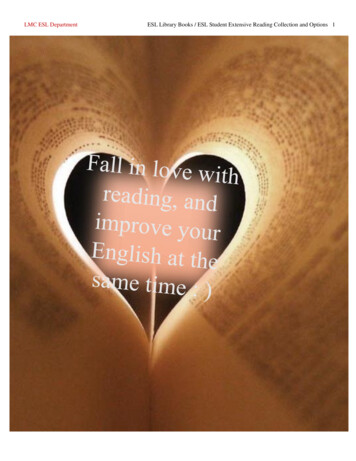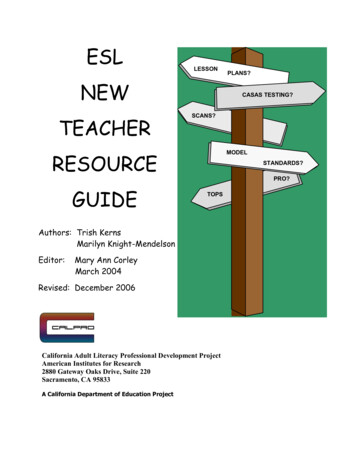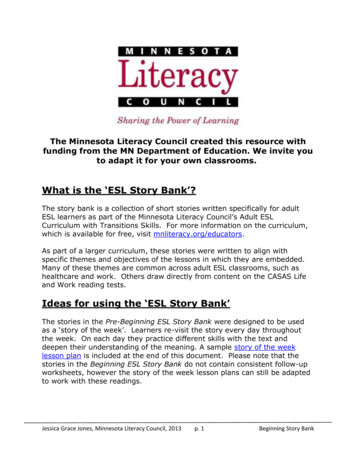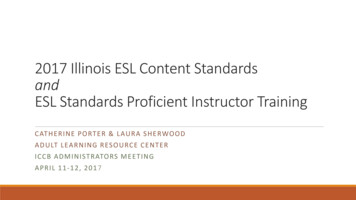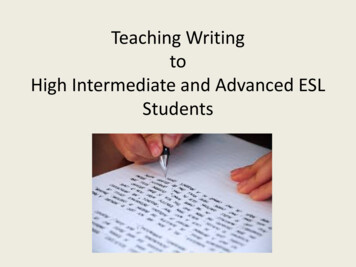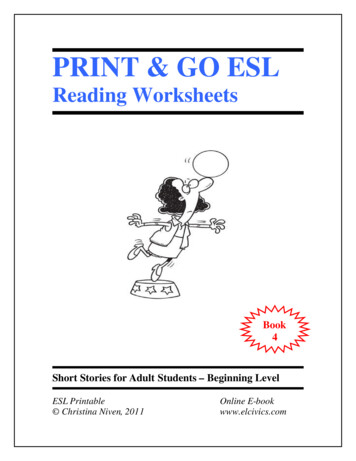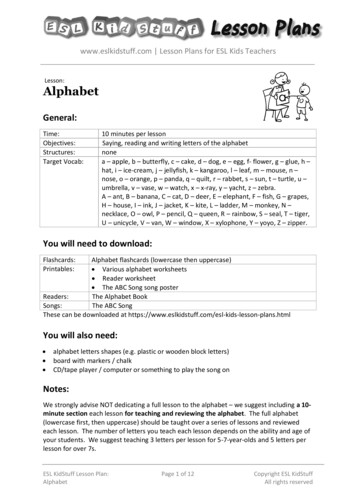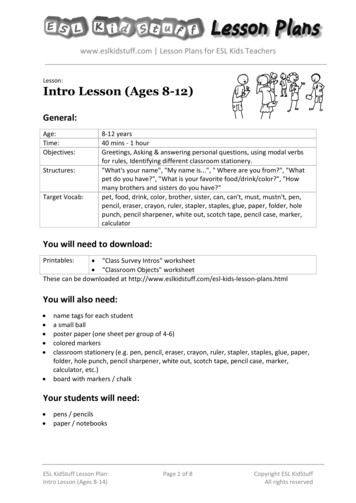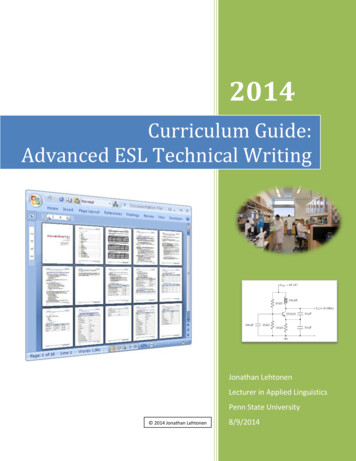
Transcription
2014Curriculum Guide:Advanced ESL Technical WritingJonathan LehtonenLecturer in Applied LinguisticsPenn State University 2014 Jonathan Lehtonen8/9/2014
Curriculum Guide: Advanced ESL Technical WritingPurpose, Audience, and Scope of this GuideThis curriculum guide proposes a model for implementing an Advanced ESLTechnical Writing course at an American university. The following material isgeared toward college ESL curriculum designers and composition instructors. Itcould be used for training instructors or for creating new courses, and it providestheoretical justification for each curricular component. This document is notdesigned as a course syllabus to be passed out to students, but many of itselements could be inserted into syllabi.1
Curriculum Guide: Advanced ESL Technical WritingTable of ContentsCourse Description and Rationale . 3Context, Resources, and Constraints . 4Adaptation to Learners . 4Additional Resources and Constraints . 5Conceptualizing Goals & Objectives . 5Course Goals . 6Goal 1: Approaching Technical Writing Rhetorically . 6Goal 2: Practical Grammar Review . 6Goal 3: Conceiving Technical Writing as Cultural Discourse . 6Course Objectives . 7Rhetoric Objectives . 7Grammar Objectives . 7Cultural Awareness Objectives . 7Conceptualizing Content & Evaluation . 8Needs Assessment. 9Steps to Take before the First Day of Class . 9Assessment during Week 1 . 9Organization of Course Units . 10Materials and Activities: Selection, Adaptation, and Creation . 11Course Schedule. 12Evaluation . 14Assessment of Progress toward Course Goals . 14Criterion-Referenced Assessment for Course Projects . 15Grammar Assessment . 15Appendix: 3 Lesson Plans for Week 1 . 16Bibliography: Research Sources and Images . 222
Curriculum Guide: Advanced ESL Technical WritingCourse Description and RationaleAdvanced ESL Technical Writing will cultivate and assess the technical communicationproficiencies of L2 students through introducing rhetorical concepts, reviewing basic grammar,and developing students’ abilities to adapt to cultural discourses. Progress towards these goalswill be achieved and assessed through discussion, readings, quizzes, and most importantly,performance assessments that simulate real world applications of technical writing. Therequired textbooks for this course are Markel’s (2012) Technical communication and GlassmanDeal’s (2009) Science Research Writing: A Guide for Non-Native Speakers of English.I have developed this course in order to meet what I perceive will be a continually growingneed. In my experience as a technical writing instructor and as a freelance editor, I have met anumber of juniors, seniors, and graduate students at Penn State who are very advanced inSTEM and other fields, but still could use extra support for written communication.The curriculum of regular technical writing courses generally assumes a native-speakerproficiency in grammar, but L2 writers would benefit from targeted grammar activities thatwould not be nearly as beneficial to L1 writers. In addition, the gap between individualdiscourse styles and American technical discourse styles will be greater for L2 writers than forL1 writers. Although both L1 and L2 student need culturally responsive pedagogy for learningtechnical writing, which is different from other forms of communication, L2 students wouldbenefit from a learning environment where the playing field is relatively more equitable, sincethey would all be encountering American communication styles as a foreign culture. Thus, thereview of basic English grammar and American communication can feel more comfortable forstudents in the absence of highly proficient native English-speaking classmates.This course could be implemented in any American university. ESL technical communicationcourses are rarer than other kinds of ESL composition courses, but I would argue that morecourses of this nature should be offered because of the benefits I stated above. However, sincethe targeted students are advanced academically, they may feel uninclined to enroll in thiscourse. Many students feel some level of stigma related to taking an “ESL” course (Marshall2010, p. 53), so I labelled it “Advanced,” in order that both students and others viewing theirtranscripts do not think it is a “remedial” course. Creating more sections of this kind of coursenationwide would also raise consciousness among technical professionals about the depth andcomprehensiveness of Advanced ESL Technical Writing.3
Curriculum Guide: Advanced ESL Technical WritingContext, Resources, and ConstraintsThe course’s underlying philosophy is that the greatest resources in the classroom are thediverse communicative and technical competencies that L2 students bring with them into thiscourse. One of the most salient socio-cultural constraints to address involves students’ ownpsychological insecurities related to being categorized as ESL students. According to Marshall(2010), students often feel embarrassed about taking ESL courses, struggling with what hasbeen termed “deficit remedial ESL identity.” Some students in this course may be residentimmigrants who moved to the US during adolescence, while others may be international orexchange students, and each group is going to face unique psychological challenges. One suchchallenge is “stereotype threat,” theorized by Steele (2006) as an experience with a measurableimpact on performance due to anxiety that others will apply negative stereotypes to oneself.In this course and beyond, preparing written communications, especially personal documentssuch as application letters, might be an experience that could trigger stereotype threat ordeficit identity for students. Therefore, the instructor’s main counterweight will be toencourage students to position themselves as cultural beings endowed with a globalizingperspective that is highly competitive in the workplace. According to Yoon (2008), aninstructor’s different kinds of social “interactive positioning” can have a positive or negativeinfluence on students’ performance, so the instructor must help students see their strengths ascarriers of intercultural border-crossing wisdom. In addition, the instructor must also encouragestudents to feel confident in their discipline-specific technical proficiencies, to help them realizehow much American society does in fact value what they have to offer.Adaptation to LearnersThe course goals and objectives, needs assessments, materials, and evaluation methods allmust synergize to address the unique professional needs of juniors, seniors, and graduatestudents in STEM and related fields at American universities. These students need to developpractical writing skills for professional and research environments, so every piece of coursecontent must relate directly to the kinds of sentences and formats they will be composing bothat the university and in the workplace.Quizzes, assignments, and activities must be designed at a precise and appropriate level, sincethese students will have a moderately high level of English proficiency and might often befunneled into a regular Tech Writing class, such as English 202C at Penn State. In other words,these students are at a borderline in their proficiency level, and the instructor will conductperiodic needs assessments to determine which objectives need the most emphasis duringclass time.4
Curriculum Guide: Advanced ESL Technical WritingAdditional Resources and ConstraintsAnother resource is students’ intrinsic motivation, which can be tapped into through thepractical career-oriented activities in the course. These students will likely be engaged inapplying for jobs, internships, and graduate programs, so some assignments will help them tofocus and edit application materials they are currently working on.A related constraint, however, is that these students will have different technical backgrounds,such as electrical engineering, agricultural science, and computer science. Some students mightbe undergraduates, and a few might be graduate students with a lot more research experience.Since Composition instructors are usually not very familiar with STEM-related disciplines, theinstructor must be flexible, and may have to do some internet navigation on students’ behalf tohelp them with the internship and job application process.Another issue would be student access to computers and the availability of classroomprojection technology, but basically this class will have to be scheduled for a computer lab.Misunderstandings about assignments and activities between the instructor and the studentsare also possible in this ESL classroom, so the instructor may need to draw from “paralogichermeneutic pedagogy,” which focuses more on the open-ended and uncodifiable nature ofcommunication (Thralls & Blyler, 2004, p. 120; Matveeva, 2005). Paralogic hermeneuticpedagogy is about approaching communication charitably, giving one’s best effort tounderstand the other. For the sake of effective classroom communication, the instructor willneed to demonstrate charitable understanding if my students lack basic computer skills or haveother unique needs. In addition, the stereotypical dryness of technical writing can becounteracted by an emphasis on how charitable methods may be used to adapt to one’sreaders.Overall, the governing principle for the material selection is the philosophy of treating studentsas already possessing valuable skills and resources to offer in the university and on the jobmarket. In addition, this approach will benefit students on the job market, because it will trainthem to use their writing to convince employers that their L2 status is actually a strength, sincethey are proficient in more than one language. Hopefully a long term consequence will be thetoppling of employer biases against former ESL students.Conceptualizing Goals & ObjectivesThe goals and objectives for this course are theoretically grounded. Graves (1996, p. 17)discusses four different kinds of goals proposed by Stern (1992) that are generally incorporatedinto courses—“proficiency goals, cognitive goals, affective goals, and transfer goals.” AdvancedESL Technical Writing emphasizes transfer goals, which “involve learning how to learn so thatone can call upon learning skills gained in one situation to meet future learning challenges”(Graves, 1997, p. 17). Transfer goals are selected because technical writing requires being ableto learn all about a particular product or process while writing a technical document and toresearch the needs of the intended audience of that document.5
Curriculum Guide: Advanced ESL Technical WritingCourse GoalsThe theoretical rationale for the following goals is also grounded in social cognitive pedagogy,which Thralls & Blyler (2004, p. 117) define as a focus on stimulating metacognitive awarenessof how to adapt to the codified conventions of a discourse community. Meeting the audience’sneeds and using standard English grammar are probably the most salient codifications forwriting in the academic and professional world.Goal 1: Approaching Technical Writing Rhetorically Students will learn to narrow down the purpose for writing any document, to researchthe needs and expectations of the audience, and to organize the content to meet theaudience’s needs.A rhetorical approach to writing means focusing on the audience. To use rhetoric effectively isboth a cognitive goal and a transfer goal, since studying involves mastering specific linguisticconcepts as well as learning how to approach novel challenges in the future.Goal 2: Practical Grammar Review Each student will identify personal opportunities for developing deeper cognitiveawareness of the structure of English, in order to produce sentences with clarity,conciseness, and precision.This is mostly a proficiency goal since it requires “mastery of specific language behaviors”(Graves, 1997, p. 17), which will be especially helpful for the future. Grammatical correctness,however politically conflicted this concept may be, is still required for academic andprofessional contexts, and future supervisors of our students will require grammaticallyincoherent documents to be rewritten.Goal 3: Conceiving Technical Writing as Cultural Discourse Students will become independent evaluators of the sociolinguistic appropriateness oftheir own writing.This transfer goal is somewhat of a rephrasing of Goal 1, concerning rhetoric, but Goal 3 willguide how the instructor approaches rhetorical issues that specifically relate to communicationdifferences between various cultures. For example, students will be learning citation styles asrequired in American discourse communities. Since there are many different citation styles andpurposes, students need to learn how to investigate any discourse community to which theybelong, both present and future, so that they can effectively evaluate their own level ofsociolinguistic appropriateness. The goal, therefore, is the prepare students to apply aspects ofthe course to the individual discourse contexts of their own academic fields.6
Curriculum Guide: Advanced ESL Technical WritingCourse ObjectivesThe following objectives are manageable steps for achieving the course goals stated above. Atypical day of class will involve working toward 2-3 of these objectives.Rhetoric ObjectivesIn order to develop their rhetorical awareness, students will use pre-writing steps for the 5 major projects to identify purpose, audience, andappropriate organization methods,conduct peer-reviews for rough drafts, andschedule student-teacher conferences for discussing.Grammar ObjectivesStudents will practice and demonstrate their grammatical proficiency through 1) quizzes, 2)short diagnostic essays, 3) written projects, and 4) student-teacher conferences. The followinggrammatical concepts with be introduced and tested in this course: Modals for polite languageIndependent vs. dependent clausesTense pairs: using past and perfect tenses togetherParallelismCompound SubjectsPassive and active voicesArticles (“a” and “the”)Adverbs and adverb locationModifiers vs. dangling modifiersTransitional phrases for paragraph cohesionThis selection is partially based on the grammar covered by Glassman-Deal (2009) in ScienceResearch Writing: A Guide for Non-Native Speakers of English. Other concepts, such areparallelism, are emphasized in Markel’s (2010) Technical Communication.Cultural Awareness ObjectivesIn order to become independent evaluators of the sociolinguistic appropriateness of their ownwriting, students will engage in the following practices throughout the course: Developing familiarity with MS Word and other communication technology, in order toformat documents according to audience’s expectationsUsing an appropriate tone for text messages, emails, more formal letters, etcAvoiding common logical fallaciesCiting sources according to the standards of one’s discourse communityPracticing IEEE and APA citation styles7
Curriculum Guide: Advanced ESL Technical WritingEthical considerations about proper acknowledgment of sources and plagiarism are notculturally universal, so American standards must be presented as a lesson in interculturalunderstanding. The development of tone in communication is also important for ESL studentsto practice due to differences in communication styles.Conceptualizing Content & EvaluationThe following diagram visualizes the various means for delivering content intended to achieveand assess progress toward the course goals. Feel free to refer to this diagram again.8
Curriculum Guide: Advanced ESL Technical WritingNeeds AssessmentDue to time constraints, the needs assessments will focus primarily on grammatical proficiency,rather than rhetorical proficiency. Ideally, the instructor would seek to identify thecommunication-related discipline-specific needs that each student has, but may not be feasible.Two needs assessments, a questionnaire and a diagnostic essay, will help the instructordetermine the “subjective needs” of students, or the needs that the students are most aware of(Graves, 1997, p. 14). In addition, the diagnostic essay, as well as any written work turned induring the first half of the course, can be analyzed for gaps in students’ grammaticalknowledge. Thus, the diagnostic essay will help the instructor hypothesize each student’s“objective needs.” Five Pretests will be another means for assessing students’ needs.The grammar Pretests will use mostly selected response (multiple choice) questions, in order tofacilitate faster grading and data collection, and also to prevent confusing questions fromharming students’ grades. The triangulated data from the questionnaires, diagnostic essays,written projects, and grammar Pretests will help the instructor determine which grammarobjectives to emphasize the most. Thus, the data provided will allow for some degree ofdifferentiated instruction. The instructor will alert students to their particular needs, in supportof the course goal to help students “identify personal opportunities for developing deepercognitive awareness of the structure of English.”Steps to Take before the First Day of ClassIn the weeks before the course, it may be possible for the instructor to login to his or her secureuniversity access account to view the list of students enrolled in the course. This list mayprovide the students’ undergraduate majors or areas of graduate study, and if so the instructorshould do some preliminary research on those fields by examining the university’s home pagesfor the relevant academic departments and doing Google searches.Assessment during Week 1On the first day of class, the instructor would utilize a questionnaire with interview typequestions about years of English study, years of usage of Microsoft Word or other Officeproducts, and years of usage of other communication technology or software. (See Appendixfor sample questionnaire.)The questionnaire will also prompt them to write down questionsabout course policies, and most importantly, to indicate what kind of skills they know they wantto improve in this course (Glenn & Goldthwaite, 2006, pp. 46-47).On the second day of class, students will write a diagnostic essay for thirty minutes, asrecommended by Glenn & Goldthwaite (2006, pp. 46-47). The instructor will first explain thatthis essay is ungraded, and then will have them write about their learning goals, learning needs,past struggles in English. Before the next class, the instructor will examine their use of grammarand devise a chart/ spreadsheet for recording the numbers of various kinds of errors (Glenn &Goldthwaite, 2006, p. 49). With this data, the instructor can adjust grammar lessons as needed.9
Curriculum Guide: Advanced ESL Technical WritingOrganization of Course UnitsThe following Units will last three weeks each:1. Writing Professional Memos and EmailsProject 1: Compose a professionally formatted memo that describes theiracademic skills and interests and career goals.2. Instruction SetsProject 2: Design a short instruction set.3. Application Letters and ResumesProject 3: Compose a resume and an application letter for a job, an internship, orgraduate school.4. Writing Product ManualsProject 4: Produce a product manual, which includes a technical description anda longer instruction set.5. Designing Websites and E-Portfolios Project 5: Design a final e-portfolio website.This assignment sequence follows the pedagogical concept of “building,” by starting withsimpler assignments first, and it also uses “recycling,” since assignment 3 is similar toassignment 1, assignment 4 is similar to assignment 2, and assignment 5 incorporates all 4previous assignments (Graves, 1996; Glenn & Goldthwaite, 2006, p. 90). The organization ofcourse units is partially based on the structure developed by the Penn State Program in Writingand Rhetoric for regular Technical Writing (English 202C). The Director of this program, CherylGlenn (2006), explains in The St. Martin’s Guide to Teaching Writing many of the theoreticalfoundations that are currently embodied in the structure of Penn State Composition courses.Some differences, however, between Advanced ESL Technical Writing and Penn State’s English202C are that the first 3 Projects of the ESL version are modified to be a little bit simpler, whileProject 4 is actually a new assignment altogether. Unit 1 in English 202C involves a rhetoricalanalysis, written in memo format, but in the ESL version the memo is more of a selfintroduction. In addition, there are 6 Projects in English 202C, whereas there are 5 Projects in10
Curriculum Guide: Advanced ESL Technical WritingAdvanced ESL Technical Writing. The grammar objectives are also much more specified in thiscourse than they would be in a regular Composition course, and the objectives are organizedbased on a building scheme and order of importance.This breadth of assignments would be appropriate for fulfilling a university’s upper-level writingrequirement for a Bachelor’s Degree. The assignments simulate the kinds of professionalinteractions and documents STEM students will likely experience in other courses and in thework world.Materials and Activities: Selection, Adaptation, and CreationTo support these assignments, the instructor will use the relevant chapters from Markel’s(2012) Technical Communication, which is an excellent text, in its 10th edition, designed forregular technical writing courses, and it is also used in the Penn State regular version ofTechnical Writing. The publisher, Bedford/ St. Martin’s, also provides many instructionalsupplements, such as quizzes, PowerPoints, and thought-provoking classroom activities, whichare accessible for free through a secure login. All of these activities and PowerPoints can bemodified and contextualized for ESL students. Using this non-ESL textbook and curriculum willhopefully boost my students’ confidence by showing them that this is not a remedial course.In accordance with the course philosophy, the assignment sheets will emphasize that these 5projects are opportunities to share their individual technical expertise as well as interculturalknowledge with others. Assignment sheets for the 5 major projects may be adapted fromassignment sheets used by the Penn State English Department, or they may be composedanew. Either way, they will need to be modified to focus on the needs of the target students.Instructors also may search online for “good” and “bad” samples of technical writing to helpstudents compare them. Sample projects from past Technical Writing student should beprovided as models (with the permission of the student). A good place to look would be EPortfolios published online for public access by past Technical Writing students.In order to support the grammatical objectives for the course, the instructor will also assignreadings and activities from the textbook, Science Research Writing: A Guide for Non-NativeSpeakers of English (Glassman-Deal, 2009). It should be noted that this is actually a Britishpublication, so the punctuation will not be Americanized. The instructor should occasionallypoint out the differences in British and American punctuation and other conventions, to deepenstudents’ cognitive awareness of these two somewhat contrasting discourses.The instructor will also develop a “matrix” of grammar exercises based on the grammarobjectives and the needs demonstrated in Pretests 1-5. A good resource for grammar exercisesis the College Workbook: Harbrace Essentials Handbook (2012) by Larry Mapp. I also personallyrecommend consulting Brooks Landon’s Building Great Sentences (2013). Instructors may needto investigate copyright licensing before using borrowed exercises in their courses.11
Curriculum Guide: Advanced ESL Technical WritingCourse ScheduleThis course schedule embodies the theoretical conceptualizations of building and recycling, aswell as other principles of assessment and curriculum design covered in this guide. Feel free torefer to this schedule again as a visual overview of the entire course. Please note that thisschedule is organized by week, so the actual daily activities could be fleshed out moreaccording to the needs of particular classes.Unit 1:Writing ProfessionalMemos and EmailsWeek123Unit 2:Objectives: Introduce course goals. Conduct needs assessments.Conventions and formatting for memos and emails. Appropriate tone.Practice modals for polite requests.Distinguish independent and dependent clauses.Activities/ContentIntroduction to CourseQuestionnaire, Diagnostic EssayGrammar PowerPoint,Worksheets, DiscussionRead Technical CommunicationChapters 1 and 14EvaluationQuestionnaire, Diagnostic EssayGrammar Pretest 1Project 1 Proposal DueGrammar PowerPoint Worksheets, DiscussionRead selections from ScienceResearch WritingGrammar Quiz 1Rough Draft Due, Peer ReviewDiscussionProject 1 Due: Self-introductoryMemoStudent-teacher conferencesObjectives: Audience adaptation, Organization, Citation styleFamiliarity with MS Word, Parallelism and Tense PairsInstruction SetsWeekActivities/Content4Grammar PowerPoint, DiscussionWorksheets, Read selectionsfrom Technical CommunicationGrammar Pretest 25Project 2 Proposal DueGrammar PowerPoint, DiscussionWorksheets, Read selectionsfrom Science Research WritingRough Draft Due, Peer ReviewDiscussionGrammar Quiz 2612EvaluationStudent-teacher conferencesProject 2 Due: Short instruction set
Curriculum Guide: Advanced ESL Technical WritingCourse Schedule, continuedUnit 3:Application Lettersand ResumesObjectives: Identifying purpose. Using appropriate tone.Avoiding fallacies. Passive and active voice, Compound subjectsWeekActivities/Content7Grammar PowerPoint, DiscussionWorksheets, Read selectionsfrom Technical CommunicationGrammar Pretest 38Project 3 Proposal DueRead selections from ScienceResearch Writing, DiscussionRough draft due, Peer reviewDiscussionGrammar Quiz 39Unit 4:Writing ProductManualsEvaluationStudent-teacher conferencesProject 3 Due: Application Letterand ResumeObjectives: Audience adaptation, OrganizationIEEE and APA citation stylesArticles (“a” and “the”), Adverb locationWeekActivities/Content10Grammar PowerPoint, WksheetsRead selections from TechnicalCommunication, DiscussionGrammar Pretest 411Project 4 Proposal DueRead selections from ScienceResearch Writing, DiscussionGrammar Quiz 412EvaluationStudent-teacher conferencesRough draft due, Peer reviewDiscussionProject 4 Due: Product ManualUnit 5:Objectives: Lean web design software, Audience/visual organizationDesign Websites and Modifiers and dangling modifiers, Transitional PhrasesE-PortfoliosWeekActivities/Content13Grammar PowerPoint, WksheetsRead selections from TechnicalCommunication, DiscussionGrammar Pretest 514Project 5 Proposal DueRead selections from ScienceResearch Writing, DiscussionGrammar Quiz 515Rough draft due, Peer reviewDiscussion13EvaluationStudent-teacher conferencesProject 5 Due: Final E-Portfolio
Curriculum Guide: Advanced ESL Technical WritingEvaluationConstructed-responses will be used for determining grades, because they require theproduction of contextualized language. Other methods such as teacher observation,conferences, and selected response questions, can be used to assess needs, since they are veryefficient for providing feedback, but they will not be used for determining grades.Performance assessments will be the main method of evaluation for this course. Bailey (1998,p. 208) defines performance assessment as a method where “the learner’s response involvedcomprehending and producing langua
Curriculum Guide: Advanced ESL Technical Writing 3 Course Description and Rationale Advanced ESL Technical Writing will cultivate and assess the technical communication proficiencies of L2 students through introducing rhetorical concepts, reviewing basic grammar, and develo
